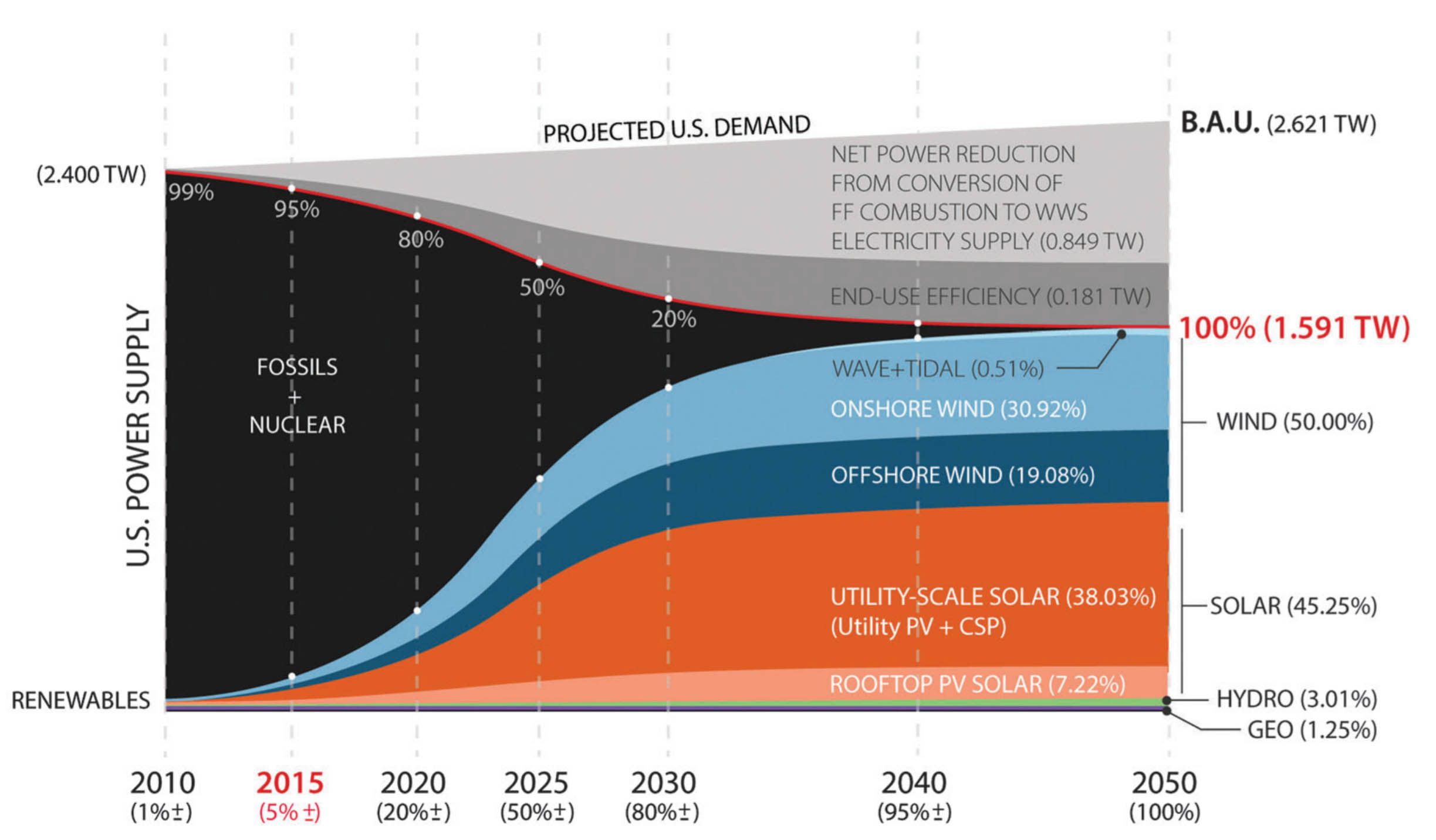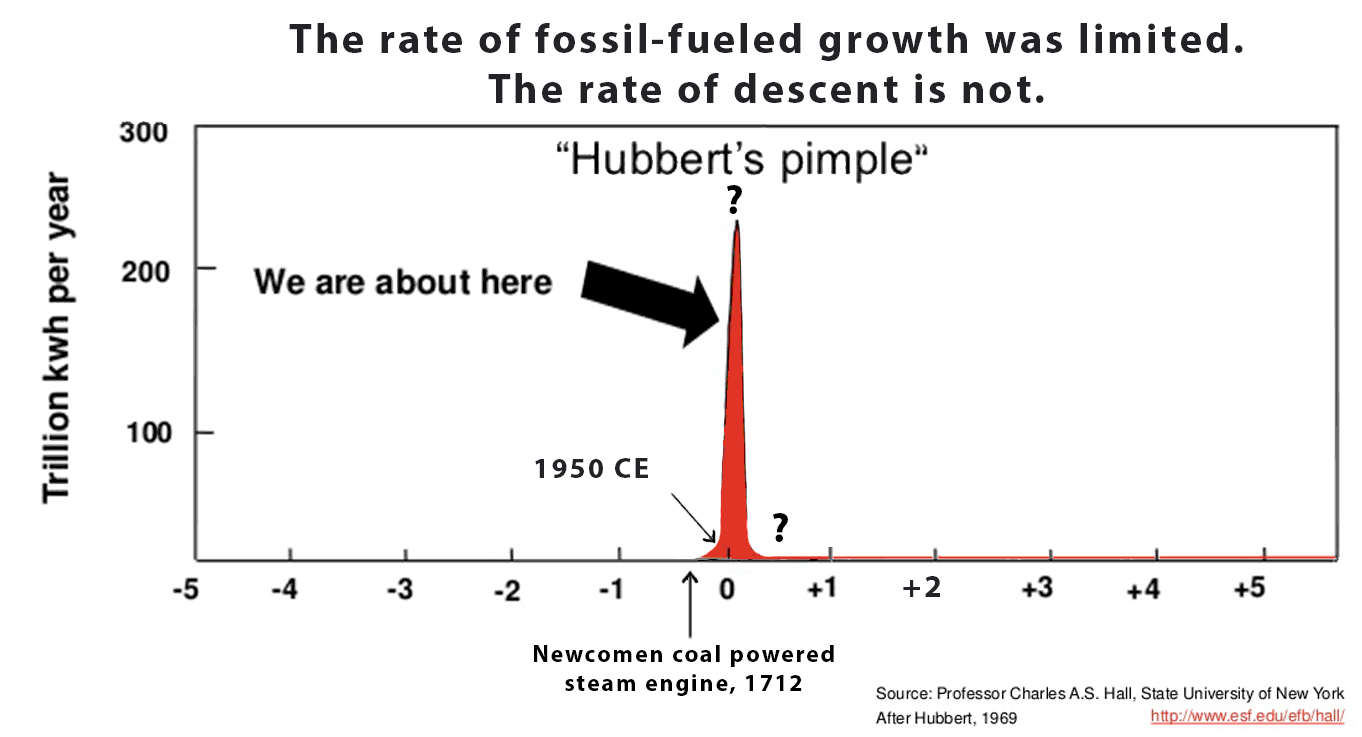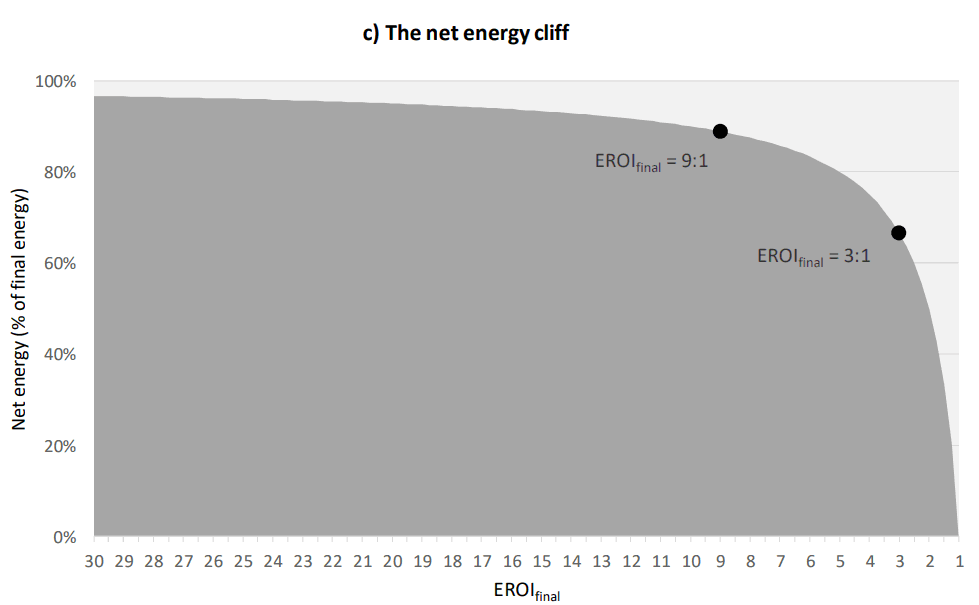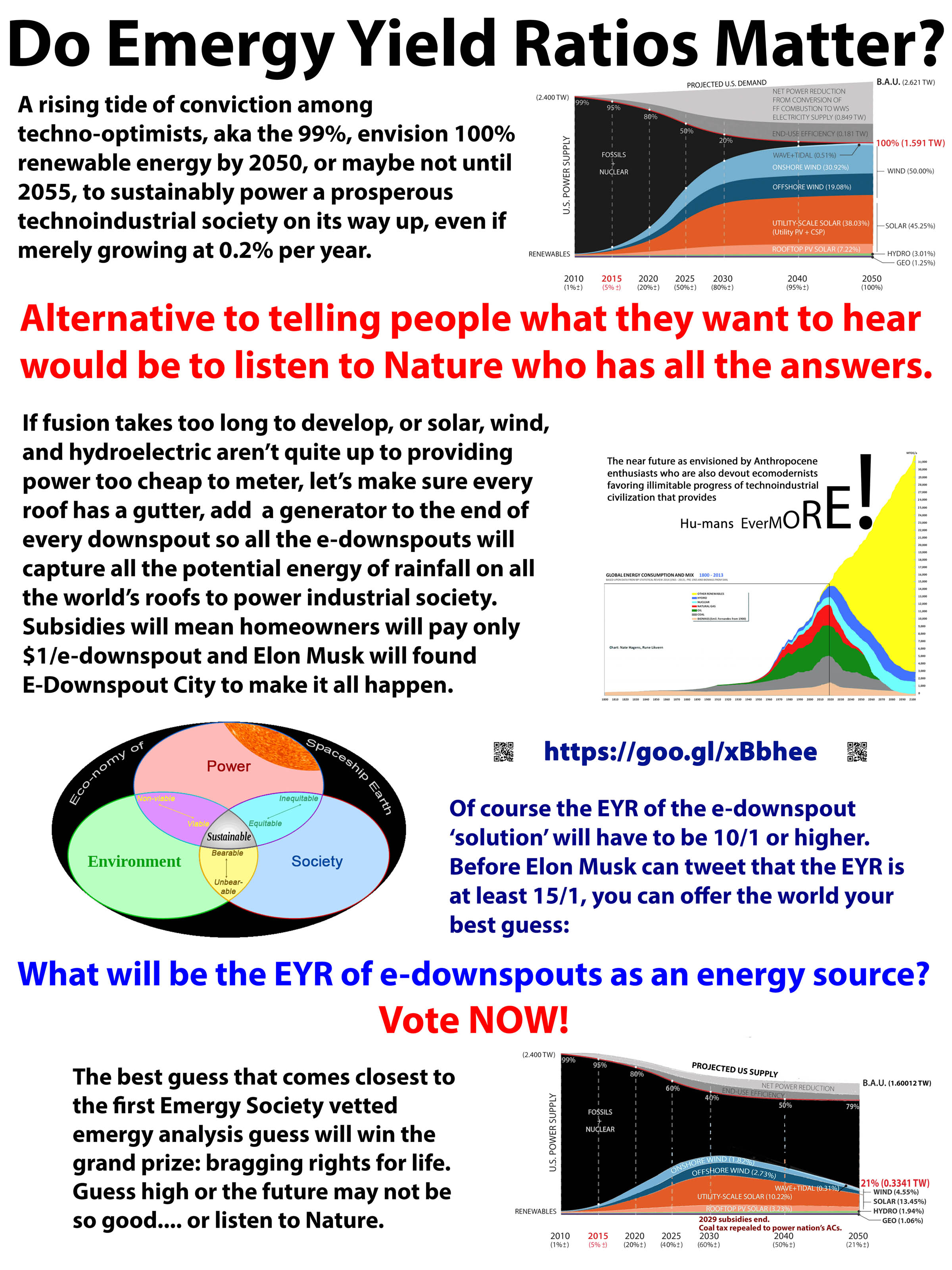
SATURDAY, April 22, 2017: NOTE TO FILE

Emergy Yield Ratios Matter
Why alternative energy isn't alternative
Eric Lee, A-SOCIATED PRESS
TOPICS: EYR, FROM THE WIRES, SOURCES OF ELECTRIC
Abstract: Some humans can grasp the notion that fossil fuels are finite, won't eMpower the consumer life as we know it forever, and perhaps should even be left in the ground, but very few can consider the possibility that alternative energy schemes are not alternative in that the energy return on investment, when extended such that all energy inputs, proximal and distal, are considered, is not comparable to fossil fuels, and so cannot eMpower industrial society as we have known it, e.g. Germany's Energiewende.
TUCSON (A-P) — Since I'm not an academic, I don't have to 'play nice' as a scrivener, and not being media, not even social, I don't have to be 'fair and balanced' or otherwise tell people what they want to hear. I don't 'like' what I write and neither will normal humans. 'I would love to be wrong in everything'. By sharing concerns, someone who may actually know enough to have an opinion may offer to correct me.
As the need to account for 'externalities' becomes increasingly evident to policy makers, some economists are considering 'internalizing externalities' by devising approaches to value non-market-traded goods and services industrial humans are normally oblivious to. Alternative biophysical thinking (Odum & Odum 2000. The Energetic Basis for Valuation of Ecosystem Services) is to 'externalize the internalities' by using energy, measured in solar energy equivalents, as the basis for valuing goods and services provided by our natural and human environments to allow adequate assessment of the environmental goods and services (EGS) Nature provides to enable humans to better manage natural environments or otherwise understand systems.
Alberta Environment of Canada asked (funded?) the International Institute for Sustainable Development (IISD) to examine the concept of eMergy as a tool for valuing EGS. Their study explored 'the advantages and disadvantages of using emergy measurements to value EGS and assess development alternatives' to support decision and policy-making and otherwise advance 'sustainable development' planning. Odum's 'better view' is beginning to be insubstantially considered by decision makers. But things are looking up: Copernicus had a 'better view' and it took the intelligentsia 150+ years to internalize it and the Church over 200 years to remove his offering from the banned book list. Although 25% of Americans agree that the Sun goes around ('orbits' as sciency types say) Earth, most intelligentsia types lost interest in the issue over a hundred years ago.
The IISD 2010 report includes an online survey of 119-137 students and alumni from schools of environmental and sustainability internship and degree programs that found 14% 'had previously heard of emergy analysis', which begs the question of whether any had been taught to think about systems in terms of energy principles. But at least 14% is a likely upper limit implying that schools of environmental and sustainability studies are still thinking about systems in Ptolemaic terms. While most members of the intelligentsia could be made to admit that 'energy matters', too few yet realize that energy principles are central to any understanding of any complex system that matters. Most ecologists, even those who may know of H.T. Odum, reject (secondary to educational deficit?) the centrality of energy concepts needed to enable humans to claim some grasp of biophysical reality or make policy decisions that might enable long-term persistence of complex society.
Other than for industrial humans living in the past three hundred years, solar energy is what matters and all other energy sources are alternative. For industrial society alone, fossil fuels matter and all other sources are considered alternative. Since only industrial humans could be reading this, 'alternative energy' will be taken to mean alternative to fossil fuels, namely: solar PV/thermal, wind, geothermal, hydroelectric, tidal, wave, biomass, nuclear fission, and fusion. All are alternative, but not in a way that really matters. Let's parse each alternative through the obligatory tell-people-what-they-want-to-hear media (mainstream and social) filter:
- Solar: Algerians note that they have enough harnessable solar energy falling on their desert alone to power the entire industrialized world. Energy stored as molten salt by day would generate power all night. It would take a bunch of really long cables to export the power everywhere, such as to the U.S., but why should Americans cover their desert with ugly solar panels? At the very least Europe can be powered by Saharan Sun.
- Wind: As the U.S. National Academy of Sciences notes, wind generation potential on land alone could provide 40 times the current world consumption of electricity from all sources. Covering the world's oceans would just take longer. The wind turbines would only cover 1% of the land, so plenty of room for crops, grazing, for solar panels too... or humans who want to sunbathe.
- Geothermal: The heat in the upper six miles of the earth's crust contains 50,000 times as much energy as found in all of the world's oil and gas reserves combined. All countries along the edge of crustal plates won't even have to drill holes six miles deep. Those around the Pacific's Ring of Fire could tap into a virtually illimitable supply of energy that will last until Sol goes nova. Accessible geothermal reserves in the U.S. alone can provide 2,000 times more energy than current use (if MIT says so, believe it). Dig down just 6 meters (20 feet) and the ground is isothermal, good for pre heating and cooling. The difference in temperature between surface ocean water and the cool deep water below can be used to generate power. Long before Earth's molten core solidifies from our energy extraction (that would eliminate the magnetic field and atmosphere), we'll have finished building a Dyson sphere, the first of trillions to come as there are more stars out there for the taking.
- Hydroelectric: While only 16% of the world's electricity comes from hydropower, mostly from dams, China, Brazil, Turkey, and even sub-Saharan Africa are building new dams. Any moving water can generate electricity, even the outflow from wastewater treatment plants. Brazil, Norway, the Democratic Republic of the Congo produce most of their power using 'in-stream' turbines without building dams. Every creek could have turbines too, so plenty of untapped hydropower. The rain coming off every roof could power a generator on its way down the downspout.
- Tidal: The tides go in, the tides go out. Provide a restriction to force the water through a turbine and energy is produced as long as the Moon orbits Earth and both orbit the Sun. Natural estuaries are ready made to dam, but dams could be constructed along all coasts. Boats could pass through locks to anchor safely within. Artificial caverns could be dug inland and underland and connected to the sea so no one's oceanside view or favorite beach would be disturbed.
- Wave: Worldwide, the harnessing of wave power could generate 10,000 gigawatts of electricity, more than double the current world use from all sources.
- Biomass: All food, fiber, wood, peat, mulch is pre-fossil fuel energy. Why wait? Use it while you got it. But turning it into biofuels for cars would be a waste as photosynthesis made corn is only about 0.5% efficient compared to solar PV at 20+% and getting more efficient all the time. Cover the fields with wind turbines that still let 99% of sunlight pass them by so cattle can graze around them or crops can be planted with electric tractors to flourish where it rains, or some of the power generated can be used to desalinate sea water to irrigate with. Or cover the land solid with solar PV panels so no light is wasted, and so the rain falling on them could be harvested. Land occupied by just wind turbines makes electricity 300 times more valuable than ethanol, so make ethanol for antique cars and power the rest with electricity.
- Nuclear fission: Breeder reactors can make fissionable material for other reactors. Any new technology has issues to work out. Nuclear 'waste' will become a valuable resource. Some early steam engines blew up, but we got over it.
- Fusion: Fusion power on earth may be a welfare program for engineers, but we're clever apes and if trillions of suns can do it, the 'impossible' will just take us a little longer. But we already have a fusion reactor nearby. We'll build a Dyson sphere, plenty of materials in the asteroid belt and Oort Cloud, and use all the energy output of Sol to grow the economy.
Note: Most of above numbers/claims are from Lester Brown's World on the Edge: How to prevent environmental and economic collapse 2011 without the overenthusiastic techno-optimist overselling bits, but without any hint it is not all good. Brown views all as alternate such that all fossil fuels could be left unused in the ground and quickly replaced by alternative sources to maintain our 'prosperity'. Environmentalists deeply believe in political solutions and 'green' technological fixes, and are seemingly oblivious to energy principles.
Jacobson et al. (2015) argue that it is feasible to provide “low-cost solutions to the grid reliability problem with 100% penetration of WWS [wind, water and solar power] across all energy sectors in the continental United States between 2050 and 2055”, with only electricity and hydrogen as energy carriers. That 100% of all energy needed to power industrial society will soon come from renewable energy sources has become an article of faith, fervently believed in by progressive political enthusiasts and their politicians. It feels so good to believe that 100% renewable energy will save us from the heat, that only the evil machinations of Big Oil and Coal could prevent the coming of the 100%. Covering the Caribbean with 78,000 wind turbines will take the worst wind out of hurricanes. Anyone who doesn't like alternative energy is a stooge for Big Fossil. But political animals don't have solutions or answers. Nature has all the answers. What does Nature say?

Congress can be expected to repeal Jevon's Paradox and the Second Law of Thermodynamics soon. By 2025, just a few years from now during which time we can confidently do nothing other than continue with business-as-usual, fossil fuel and nuclear will be rapidly fading from memory. Be sure to save a jar of gasoline so your grandchildren can open it and smell what cars used to run on. Be sure to recall the above vision of the future and compare to the claims of naysaying eco-fascists when 2025 comes. If expectations for 2025 fail, consider that those for 2050 may 'differ' too and that maybe you should be concerned.
All alternative energy sources have their enthusiastic proponents. When funding is available, when people want to believe, oversellers come out of the lab work to line up at the trough. Reminds me of when I was a kid looking at the ads for devices in the back of Popular Mechanics magazine that would, guaranteed, increase a car's fuel economy by at least 20 percent. My dad noted that if you installed all of them you'd have to stop every few hundred miles or so to drain off the extra gas. None actually worked other that to get someone to buy it. Buyer beware: sellers oversell to maximize short-term gain.
Let's go slow at first, go easy on the confirmation bias, and let the biophysical realities creep in. Yes, if every roof had downspouts and every downspout had a water-driven turbine/generator in it, then every time it rained electricity would be generated. Aside from the gutter, downspout, and generator, there would be wire, conduit, and regulator/inverter/fuses... needed to grid-tie each e-downspout. Effort (energy) would be required to install and maintain the system.
All bits and pieces will take energy to make: to mine, transport, smelt, process, manufacture, more transport, repairs, replacement..., and people (or robots) are also needed who also need energy. All the energy inputs into each bit and piece, including installation, maintenance, replacement..., and the indirect services of those who support those directly involved— from preachers to prostitutes..., are real, are needed to make the system work (ask any preacher or prostitute).
The people making the system work may need years of education which is another energy input. It all takes money too, but that has nothing to do with biophysical reality. Money is an incomplete measure that creates an illusionary view of how the system works (talk to any conventionally trained economist). Energy, not money, makes the system go around—all systems. We are subsystems. Our economy is a subsystem of society which is a subsystem of the environment. It is subsystems (energy hierarchies) all the way down and up to system (singular), aka the universe, the what-is..., Nature.
Each e-downspout bit and piece and service has an energy memory (that business-as-usual humans are oblivious to), but the need for that energy doesn't go away because we are ignorant of it. The embodied energy (all the energy of various forms needed to produce the final form) is called emergy with an 'm', a measure of real wealth, the work (measurable in solar emjoules or emcalories) previously required to generate a product or service. It is the energy that is used directly and indirectly to make a product or provide a service, and it's not just a funny made-up word meaning nothing that matters. The emergy in the e-downspout system, compared to the emergy of the electricity produced, would likely be less than 1, meaning there is more energy embodied in the system than the system can produce... meaning no net emergy production..., meaning it's a delusional system for producing net energy. It won't work as a source to power industrial society.
Solar PV and e-downspouts produce energy. Absolutely, but neither will power continued exponential growth of the industrial system as we have come, in the past 200 years, to regard as normal. The growth pulse we are living in is 90%+ due to our profligate use of one time only fossil fuels that will take hundreds of millions of years to partially replace assuming the Anthropocene extinction event doesn't 'go too far' (i.e. include too many species).
E-downspouts could be made and the makers of them could stand next to them grinning and pointing and yelling 'It works!' (as seen on YouTube), but it would only 'work' by turning a bunch of energy of various kinds into a lesser amount of energy of another kind (electric) to light the bulb the grinning technician is holding up. Energy out, real though it is, that is a fraction of all the energy in, is not an energy source. There would be no net emergy in the electricity produced by a rain gutter to e-downspout energy production system. It would be a net energy consumer. All the energy output of all the e-downspouts would not be enough to power the system that made them to keep on making them. Coal could be used to make them that gives the appearance of producing net emergy (a 100W solar panel is currently made of maybe 1-4 tons of coal? Proponents don't know, don't want to know, and want to believe it doesn't matter.).
So the emergy yield ratio (EYR where 'yield' is 'total emergy requirement', or 'total emergy cost assigned to the yield'). EYR is the ratio of emergy in the yield to that required from the economy for extraction and processing. It is what determines whether a proposed system/scheme will work—not our deeply held beliefs or strident claims. Grinning propeller-heads can easily calculate how many gigawatts all the e-downspouts on every roof in the world would produce. Clever marketing could create public support; politicians could vote for taxpayer funds to pay for the scheme; the cost to the homeowner could be $1 each. The industry thus subsidized would grow, billions of e-downspouts may be made and installed (a few humans become billionaires), the promised number of gigawatts is produced..., but it is all a slight of mind trick the sellers and buyers (who just want to believe, who would rather believe than know) may be entirely unaware of.
The bottom line biophysical reality would be that a lot of coal in China would be burned to make all the bits and pieces, ship them worldwide by diesel sucking cargo ships, and no net emergy is produced. The factories making e-downspouts, the ships transporting them, and so on, could not be powered by e-downspouts. When fossil-fuels ran short, all the e-downspouts in the world wouldn't be able to make enough e-downspouts or otherwise keep industrial society going. Once again the promises would amount to a story, imagined or temporarily made 'real', of clever apes finding ways to turn actual fossil fuel that really does exist (for a time) into products others will buy. And then what?
Global installation of e-downspouts to save the world hasn't been proposed (yet) as there are seemingly more credible energy sources. Environmentalists love solar, it is just so feel-good. Solar tiles or panels will cover all roofs, transparent solar panels will replace windows; solar PV on cars, road surfaces, and parking places will keep them going; solar buses will transport those who can't afford a solar car..., and vast solar arrays in the desert will power lasers aimed at the tail-end of rockets as they head off into space.... What's not to like about solar?
Well, we're back to that goddamn biophysical reality shit again. Early solar PV systems had no net emergy yield. They were made using fossil fuel inputs as they still are. To provide electric on spacecraft, no problem, PV works right and well, but any scheme to launch hectares of solar panels into space to beam power down via microwaves to power the global growth economy won't work as more energy will be needed to make the arrays, put the arrays into space and maintain them than they would ever in a million years produce. But proponents (as usual) can and therefore will claim that if the panels are really lightweight, 32% efficient, and made to last a billion years, along with all other components of the system (all just requiring research funding, thank you very much), then it will have a net positive EYR (emergy yield ratio), so BUY stock in the company now.... and if the government subsidizes the venture, Elon Musk will make more billions.
For solar PV on earth's surface, prospects are better. In one attempt to measure the EYR of solar, a non-trivial task, a 2009 study came up with an EYR of essentially 1. If a Manhattan Project style clever ape effort was made, an EYR of 2.x might be possible (a recent estimate of solar PV EYR is 1.8/1) which would produce some power over and above what was needed to support a solar economy where all electrical power is produced by solar. This would be better than nothing (EYR = 1) or impossible (EYR < 1). The question is, 'so would an EYR of 2.x support life as we know it? You know, like the sort of life I'm used to? And where's that lattè I ordered?'
The early prosperity (growth) of the Industrial Revolution, as evidenced by global population growth from 0.65 billion to 7.5 billion today, over a ten fold increase in a cosmic heartbeat, was empowered by an EYR of about 100/1 when coal could be scraped up from outcroppings and put in bushel baskets. It took more energy to follow the coal seams underground and more to power steam engines to pump the water that was filling the coal mines, but the story of early fossil-fuel extraction lasting into the 21st century was one of meteoric fossil-fueled growth. The EYR was down to about 40/1 by the 1970s, down to about 10/1 now, and heading down. So if solar is 1.x/1 but maybe could be 2.x/1, what EYR is needed to support life (industrial society) as we know it? The best-guess answer gets all sciency and there may be only a few hundred humans on the planet who know enough to have an opinion (which could be wrong), but a non-delusional good guess would be 4/1-5/1. If so, this is why solar PV is NOT ALTERNATIVE.
Solar PV is real, it could be used as it is on spacecraft or for high-value needs, such as recharging AA batteries to power LED headlights people wear on their head at night to get around the home or read assuming a 5W solar PV/AA battery/LED system has a higher EYR than candles and that industrial production can be maintained, along with the information (know-how) needed to keep high-tech going. The actual EYR of solar PV is unknown and the solar industry, those overselling the technology, don't want to know or think about it. It may be that solar panels will have to be made using high-power sources such as existing hydroelectric dams which were made using abundant fossil-fuels in the 20th and early 21st centuries.
The EYR of wind is better than solar assuming the wind turbines are located in windy areas (just as dams work best located on rivers). Turning fossil-fuel into subsidized wind farms looks doable, since they are cropping up where subsidized, but in a world where wind generated electric power makes the explosives that loosen the ore that the electric loaders load into the electric dump trucks that fill the electric train cars..., the output will not be as energetically 'cheap' as we are used to.
Those living on the Falkland Islands have the wind, may do well to let coal in China be turned into wind turbines and sailboats while the coal lasts. But long-term, replacing sailboats and wind generators, etc. with what they can sustainably export to trade for needed imports will be limited. They need to downsize their consumption to match environmental resources of their islands and the earth island they are part of. Everyone else on the planet will have to do the same. Wind is alternative, but it will not fuel continued exponential growth at the rate we are used to and depend on (for a time before transitioning to degrowth whether prosperously or kicking and screaming).
Emergy Yield Ratio
of sources of
electric power yielding net emergy
| Solar thermal | 1.x |
| Solar PV | 1.x |
| Ocean-thermal power plant | 1.5 |
| Coal-fired power plant | 2.5 |
| Rainforest wood power plant | 3.6 |
| Nuclear electricity | 4.6 |
| Geothermal electric plant, volcanic area | 5 |
| Wind, strong steady wind regime | 6 |
| Hydroelectricity, mountain watershed | 10 |
| Tidal electric, 25 ft tidal range | 15 |
Solar PV, if it were less than 1 would produce no net emergy, would not be a source of electricity in the big picture. If greater than 1, it can produce 'some' net emergy. Solar has not been proven to be a net producer able to power an economy. Yelling loudly that it can doesn't matter. Solar PV is positive, but don't expect it to be more than 2.x. Solar is the only potentially viable source of some electricity that is widely distributed. Strong steady winds are not. Wood production is more limited in range and amount than can be sustainably harvested to produce electricity, at least not enough electricity to power life as Americans know it. Nuclear, like fossil, isn't sustainable. Hydroelectric, geothermal, and tidal provide high quality energy that could power industrial production (of solar panels, wind turbines, bicycles, electric motors, metals, glass, computers), but only in places and not on the scale seen in the fossil-fueled 18th-21st centuries.
The highest value product of industrial society is not cars, TVs, social media..., but information and information technology that the limited high energy areas on earth could support and perhaps provide humans living on Nature's services and resources elsewhere with 10-20 watts of solar PV electric for personal use to charge their smartbook and provide LED+battery lighting. If smartbooks could store information (text, images, video) and could acquire more information from a local library server than could be considered in a week, that could be alternative to the nasty/brutish/short life typical of societies that fail to preserve information. Managing to not end up eating each other would be a plus.

Source: Charles A. S. Hall, State University of New York http://www.esf.edu/efb/hall/
After M. King Hubbert, 1969. The questions: how high the glow and how fast the descent?
The above guess has peak everything occurring in about a hundred years, an optimistic projection.
So why wait? Deglow NOW! in the next decade or so while the moving is easy.
If the distribution of potential deglowers, currently <0.01%, is random, then what?
"The people of Easter Island disappeared, leaving only their monuments as an example to the world of what happens when culture cannot downsize to fit its environmental production." — Howard T. Odum

'The people' who put up 887 high-rise statues also devised the Rongorongo writing system. No one who could read it survived. Ergo the information content of their culture, 'the people', disappeared other than as remnant population.
The Indus Valley civilization, at its height larger than the Egyptian or Mesopotamian empires, collapsed and no one who could read the Harappa script survived. The Elam civilization developed writing and no literate Elamite passed on their knowledge or ability to read. The Minoans on Crete developed writing and no one survived the passing of their civilization who could read it. The Mayans developed writing but no one who could read it survived, though a few books survived burning by the Conquistadors that were deciphered. Likely less than 10% of Classical Greek writing survived. To preserve the information of the current empire, will data stored in an Arctic vault in Norway be readable by anyone in a thousand years? Don't count on it. A Plan B should focus on human-readable information stored on pages of a long-lasting medium that a human with a hand and ability to speak a natural language could, with help of a Rosetta book, be able to teach themself to read.
"If society does not succeed in changing attitudes and institutions for a harmonious descent, the alternative is to prepare information packages for the contingency of restart after crashing." — H.T. Odum
"I have played many roles sometimes with the majority, but more often attempting to shock the scientific establishment into a better view." — Howard T. Odum
"People would rather believe than know." — E.O. Wilson
"Nature has all the answers, so what is your question?“ – H.T. Odum
Burden of proof: A comprehensive review of the feasibility of 100% renewable-electricity systems
B.P. Heard, B.W. Brook, T.M.L. Wigley, C.J.A. Bradshaw, April 2017ABSTRACT
An effective response to climate change demands rapid replacement of fossil carbon energy sources. This must
occur concurrently with an ongoing rise in total global energy consumption. While many modelled scenarios
have been published claiming to show that a 100% renewable electricity system is achievable, there is no
empirical or historical evidence that demonstrates that such systems are in fact feasible. Of the studies
published to date, 24 have forecast regional, national or global energy requirements at sufficient detail to be
considered potentially credible.... Read it with doubt intact because you'd rather know than believe.
The Jacobson et al. paper was countered, 'Evaluation of a proposal for reliable low-cost grid power with 100% wind, water, and solar', Clack et al. 2017, which provoked a twitterstorm and threats of a lawsuit—not science-as-usual. Neither 'side' may know enough to have an opinion, but just appear to as neither side imagines the possibility that they don't know enough to have an opinion. When PhD's pile it high and deep, listen to Nature—because one or both sides are not. When our PFC is hijacked by our amygdala, individually or collectively, expect at least a standard deviation reduction in IQ.
Asume the world will transition to 100% renewable everything. Or not. Either way, ask, 'And then what?'

Systems science is a candle in the dark that H.T. Odum did so much to brighten. We need to keep the bigger and arguably 'better view' in focus. As Joseph Conrad noted: 'The yarns of seamen [specialists] have a direct simplicity, the whole meaning of which lies within the shell of a cracked nut. But…to Marlow [as systems scientist] the meaning of an episode was not inside like a kernel but outside, enveloping the tale which brought it out only as a glow brings out a haze.' (Heart of Darkness).
It is through the macroscope that humans can take in something of the glow of biophysical reality reflected by particles of fact. To focus on meeting the growing demand by decision makers for emergy analysis (it is not the big-picture science they want) may be to lose sight of the bigger view, to fly moth-like into their well funded but temporary light. The economic system has found a value in emergy analysis. It is entirely primate to value being appreciated and paid to serve industrial society. Meanwhile the pace of planetary destruction may/will not slow.
Success can be one's greatest enemy. In terms of H.T.'s 'better view' nothing may fail like worldly success. If decision makers are informed by emergy analyses, the next question, as always, is 'And then what?' Will society be turned around before hitting the wall of biophysical limits or at least opt for a managed descent, as prosperous a one as possible, as alternative to chaotic collapse? If informing the public of emergy matters serves only to distract, then being distracted from the big picture fails in the long run. We may do well to keep our collective eye on the ball and think about how best to play the global endgame. We may not have time for illimitable distractions.
'For the first time in history a conviction has developed among those who can actually think more than a decade ahead that we are playing a global endgame. Humanity's grasp on the planet is not strong. It is growing weaker. Our population is too large....' — Edward O. Wilson, Half Earth: Our Planet's Fight for Life 2016
The Jacobson et al. guess is an easy sell. It merely envisions a future those who know enough to be concerned want to believe in. All projections are guesses, ranging from delusional feel-good to best guess secondary to listening to Nature. Industrial humans don't have a shortage of supply problem. They have a longage of demand problem, and Nature has negative feedback loops that are curative. The projection below is delusional fantasy, just not feel-good. Of all possible futures, post-exponential growth phase, most aren't feel-good. There are biophysical limits to the rate of growth. The rate of degrowth can be far more rapid than below.

*2029 is a hundredth anniversary. What if projected to 2150?, 2250?, 2350? Fossil fuel supply is limited. Nuclear and all sustainable supplies of energy via technology and industrial agriculture have so far been massively subsidized by fossil fuels, e.g. no hydroelectric dam has been built using hydroelectric power and so on. When 'alternative' energy alone supports industrial society, the available sustainable energy will not equal the energy wealth fossil fuel provided for a time. On average, hydroelectric dams have a life expectancy of about 400 years. Solar PV lasts maybe 30 years and wind generators last about 15 years. And when they can no longer be made using fossil fuels, then what?
2021 Update: The extended ERIO metric, when fully extended, equals EYR. A recent study of alternative sources of energy is of interest. Basically only hydropower has enough energy return on energy invested to be viable. Large hydroelectricity currently has a high EROIext ~ 6.5:1, while the rest of variable renewables are below 3:1: onshore wind (2.9:1), offshore wind (2.3:1), solar Photovoltaic (PV) (1.8:1), and solar Concentrated Solar Power (CSP) (<1:1). These results indicate that, very likely, the global average EROIext levels of variable renewables are currently below those of fossil fuel-fired electricity and so are not actually alternative. Standard, Point of Use, and Extended Energy Return on Energy Invested (EROI) from Comprehensive Material Requirements of Present Global Wind, Solar, and Hydro Power Technologies
Expect a lower energy world, and sooner is better. As H.T. Odum noted: 'Seek out the condition now that will come anyway.'
SUBNOTE TO FILE 5/8/22:
The measure of EROI varies with where the boundary is set. EYR lacks boundaries. The comparable EROI measure is extended EROIext. The following study is of interest: Standard, Point of Use, and Extended Energy Return on Energy Invested (EROI) from Comprehensive Material Requirements of Present Global Wind, Solar, and Hydro Power Technologies. From abstract:
Whether renewable energy sources (RES) will provide sufficient energy surplus to entirely power complex modern societies is under discussion. We contribute to this debate by estimating the current global average energy return on energy invested (EROI) for the five RES technologies with the highest potential of electricity generation from the comprehensive and internally consistent estimations of their material requirements at three distinct energy system boundaries: standard farm-gate (EROIst), final at consumer point-of-use (EROIfinal), and extended (including indirect investments, EROIext). EROIst levels found fall within the respective literature ranges. Expanding the boundaries closer to the system level, we find that only large hydroelectricity would currently have a high EROIext ~ 6.5:1, while the rest of variable RES would be below 3:1: onshore wind (2.9:1), offshore wind (2.3:1), solar Photovoltaic (PV) (1.8:1), and solar Concentrated Solar Power (CSP) (<1:1). These results indicate that, very likely, the global average EROIext levels of variable RES are currently below those of fossil fuel-fired electricity.

Note that EROIext is a lower number, well over the cliff.
The following poster was shown at the 10th Biennial Emergy Research Conference, Gainsville, FL, in January 2018.Guesses ranged from 10:1 to less than 1, so best guess, prior to doing the math based on relevant data isn't good.
